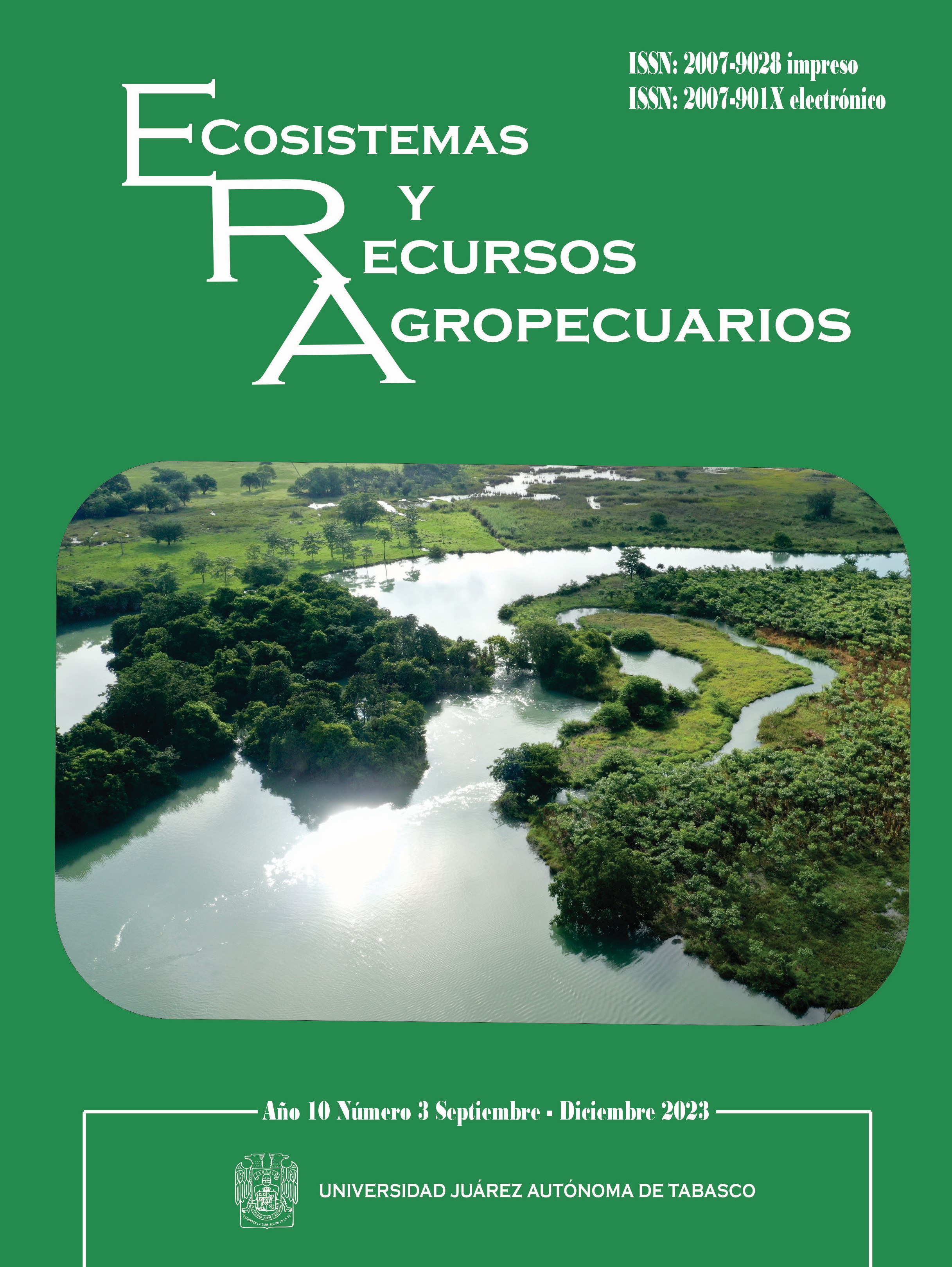The ozone concentration and tree vitality at the metropolitan zone of Guadalajara
DOI:
https://doi.org/10.19136/era.a10n3.3824Keywords:
casuarina, contaminación atmosférica, eucalipto, fresno, salud del arboladoAbstract
Air pollution, par ticularly tropospheric ozone (O3 ), when present in high concentrations, affects urban tree health. This study analyzed the ozone concentration and the potential effect on the vitality of the trees located in the metropolitan area of Guadalajara. Data from the Jalisco air quality monitoring network and photosynthetic activity through chlorophyll fluorescence of Fraxinus uhdei, Eucalyptus camaldulensis, and Casuarina equisetifolia were studied. A generalized extreme value model was fitted to estimate the atmospheric distribution and identify areas with the highest concentration of ozone. An analysis of variance was carried out to evaluate possible changes in the condition of the vitality due to the ozone concen- tration in the atmosphere. The areas with the highest ozone concentration were in Tlaquepaque, Zapopan, and the northeast of Guadalajara. No significant effect of areas with higher ozone concentrations on tree vitality was observed.
Downloads
References
Blanco ME, Vaquera H, Villaseñor JA, Valdez-Lazalde JR, Rosengaus M (2014) Metodología para investigar tendencias espacio-temporales en eventos meteorológicos extremos: caso Durango, México. Tecnología y Ciencias del Agua 5: 25-39.
Blanco-Ward D, Rocha A, Viceto C, Ribeiro AC, Feliciano M, Paoletti E, Miranda AI (2019) Validation of meteoro- logical and ground-ozone WRF-CHIMERE simulations in a mountainous grapevine growing area for phyto- toxic risk assessment. Atmospheric Environment 259: 118507. DOI: 10.1016/j.atmosenv.2021.118507.
Callow D, May P, Johnstone DM (2018) Tree vitality assessment in urban landscapes. Forests 9: 1-7. DOI: 10.3390/f9050279.
Cano-Baudino YN, Morales-Mariño JA, Sánchez-Castillo LJ, Colina-Rincon MN, Torres-Puente JC (2016) Eva- luación de los niveles de ozono en la ciudad de Maracaibo, estado Zulia, Venezuela. Revista Internacional de Contaminación Ambiental 32: 25-34.
Cassimiro JC, Moraes RM (2016) Responses of a tropical tree species to ozone: visible leaf injury, growth, and lipid peroxidation. Environmental Science and Pollution Research 23: 8085-8090.
Contran, N, Poletti E, Manning WJ, Tagliaferro F (2009) Ozone sensitivity and ethylenediurea protection in ash trees assessed and JIP chlorophyll a fluorescence transient analysis. Photosynthetica 47: 68-78.
De Quevedo F, Asprilla Y, González M (2017) Entropías de la movilidad urbana en el espacio metropolitano de Guadalajara: Transporte privado y calidad del aire. Revista Tecnura 21: 138-149.
Escarela G (2012) Extreme value modeling for the analysis and prediction of time series of extreme tropospheric ozone levels: A case of study. Journal of the Air and Waste Management Association 62: 651-661.
Figueroa MA, Davydova-Belitskaya V, Garibay CG, Parada GT, Orozco-Medina MG (2016) PM10 y O3 como factores de riesgo de mortalidad por enfermedades cardiovasculares y neumonía en la Zona Metropolitana de Guadalajara, Jalisco, México. Ingeniería 20: 14-23.
Fonseca-Hernández, M, Tereshchenko I, Mayor YG, Figueroa-Montaño A (2018) Atmospheric pollution by PM10 and O3 in the Guadalajara metropolitan area, Mexico. Atmosphere 9: 243. DOI: 10.3390/atmos9070243.
Gao F, Calatayud V, García-Brejio F, Reig-Armiñana J, Feng Z (2016) Effects of elevated ozone on physiologi- cal, anatomical and ultrastructural characteristics of four common urban tree species in China. Ecological Indicators 67: 367-379.
Gerosa G, Ferretti M, Bussotti F, Rocchini D (2006) Estimates of ozone AOT40 from passive sampling in forest sites in South-Western Europe. Environmental Pollution 145: 629-635.
Guidi L, Remorini D, Cotrozzi L, Giordani T, Lorenzini G, Massai R, Nali C, Pellegrini E, Trivelini A, Vangelisti A, Vernieri P, Landi P (2016) The harsh life of an urban tree: the effect of a single pulse of ozone in salt-stressed Quercus ilex saplings. Tree Physiology 37: 246-260.
Hansen A (2020) The three extreme value distribution: An introductory review. Frontiers in Physics 8: 604053. DOI: 10.3389/fphy.2020.604053.
Hogsett WE, Tingey DT, Lee EH, Breedlow PA, Andersen CP (2008) An approach for evaluating the effectiveness of various ozone air quality standards for protecting trees. Environmental Management 41: 937-948.
Hoshika Y, Watanabe M, Kitao M, Haberle KH, Grams T, Koike T, Matyssek R (2015) Ozone induces stomatal narrowing in European and Siebold’s beeches: A comparison between two experiments of free-air ozone. Environmental Pollution 196: 527-533.
Jackovljevic, T, Lovreskov L, Jelic G, Anav A, Popa I, Fornasier MF, Proietti C, Limic I, Butorac L, Vitale M, De Marco A (2021) Impact of ground-level ozone on Mediterranean forest ecosystems health. Science of Total Environment 783: 147063. DOI: 10.1016/j.scitotenv.2021.147063.
Johnstone D, Tausz M, Moore G, Nicolas M (2012) Chlorophyll fluorescence of the trunk rather than leaves indicates visual vitality in Eucalytus saligna. Trees 26: 1565-1576.
Jolivet Y, Bagard M, Cabané M, Vaultier MN, Gandin A, Afif D, Dizengremel P, Thiec DL (2016) Deciphering the ozone-induced changes in cellular processes: a prerequisite for ozone risk assessment at the tree and forest levels. Annals of Forest Science 73: 923-943.
Kim, KJ, Kim YJ, Ma YI, Kim JC, Sunwoo Y (2007) A modeling study of the impact of natural and urban forest on ambient ozone. Korean Journal of Chemistry Engineering 25: 483-492.
Krupa S, McGrath MT, Andersen CP, Booker FL, Burley KO, Chappelka AH, Chevone BI, Pelly EJ, Zilinskas BA (2007) Ambient ozone and plant health. Plant Disease 85: 4-12.
Macías-Muro A., Martínez-Trinidad T, Valdez-Lazalde JR, Romero-Sánchez ME, Vaquera-Huerta H (2022) Eva- luación de la salud del arbolado urbano a través de imágenes satelitales en Guadalajara, México. Entrecien- cias: Diálogos en la Sociedad del Conocimiento 10(24): 1-12. DOI: 10.22201/enesl.20078064e.2022.24. 81200.
Martinez-Trinidad T, Plascencia-Escalante FO, Islas-Rodríguez L (2012) La relación entre los carbohidratos y la vitalidad en árboles urbanos. Revista Chapingo. Serie Ciencias Forestales y del Ambiente 19: 459-468.
Nájera Cedillo MC, Márquez Azúa B, Sánchez Goméz R, Corona JP (2005) Los sistemas de información geográ- fica como herramienta para observar el comportamiento del ozono en la Zona Metropolitana de Guadala- jara. GEOS 25: 368-376.
Okorie IE, Akpanta AC, Osu BO (2019) Flexible heavy tail distributions for Surface ozone for selected sites in the United States of America. Ozone: Science and Engineering 41: 473-488.
Ooka R, Khiem M, Hayami H, Yoshikado H, Huang H, Kawamoto Y (2011) Influence of meteorological conditions on summer ozone levels in the central Kanto area of Japan. Procedia Environmental Sciences 4: 138-150.
Pal S, Mazumdar D (2015) Stochastic modelling of monthly rainfall volume during monsoon season over Gangetic West Bengal, India. Nature Environment and Pollution Technology 14: 951-956.
Pontius J, Hallet R (2014) Comprehensive methods for earlier detection and Monitoring of forest decline. Forest Science 60(6): 1156-1163.
R Core Team (2019) R: A language and environment for statistical computing. R Foundation for Statistical Com- puting, Vienna, Austria. https://www.R-project.org/ Consultado: 14 de junio de 2022.
Tobias A, Scotto MG (2005) Prediction of extreme ozone levels in Barcelona, Spain. Environmental Monitoring and Assessment 100: 23-32.
Zolghadri A, Henry D (2003) Minimax statistical models for air pollution time series. Application to ozone time series data measured in Bordeaux. Environmental Monitoring and Assessment 98: 275-294.
Downloads
Published
Issue
Section
License
Copyright (c) 2023 Ecosistemas y Recursos Agropecuarios

This work is licensed under a Creative Commons Attribution-NonCommercial-ShareAlike 4.0 International License.
Aviso de copyright
Los autores que se envían a esta revista aceptan los siguientes términos:
una. Los autores conservan los derechos de autor y garantizan a la revista el derecho a ser la primera publicación del trabajo con una licencia de atribución de Creative Commons que permite a otros compartir el trabajo con un reconocimiento de la autoría del trabajo y la publicación inicial en esta revista.
B. Los autores pueden establecer acuerdos complementarios separados para la distribución no exclusiva de la versión del trabajo publicado en la revista (por ejemplo, en un repositorio institucional o publicarlo en un libro), con un reconocimiento de su publicación inicial en esta revista.
C. Se permite y se anima a los autores a difundir su trabajo electrónicamente (por ejemplo, en repositorios institucionales o en su propio sitio web) antes y durante el proceso de envío, ya que puede conducir a intercambios productivos, así como a una cita más temprana y más extensa del trabajo publicado. (Consulte El efecto del acceso abierto).


